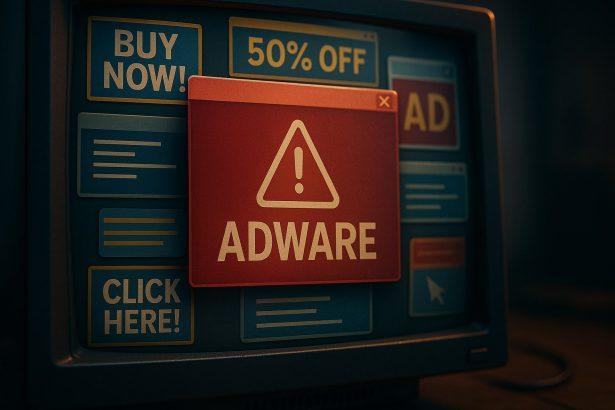A surge of deceptive browser prompts has emerged around late June 2025, ensnaring visitors with fake CAPTCHA tests before demanding “Allow” clicks. A recent case on June 23, 2025 showed the site oveprotocol.co[.]in tricking users into consenting to unsolicited ads and redirects. What happens if one unknowingly grants permission? The result: a barrage of intrusive pop-ups, slowed browsing, and potential exposure to further threats.
Threat Overview
Ads by oveprotocol.co.in falls under browser hijacker/adware. It abuses legitimate web-notification features to deliver aggressive, sponsored content. Once enabled, these notifications can push links to scams, untrustworthy downloads, and even more malicious payloads.
In-Depth Analysis
Infection Vector
Users most often encounter oveprotocol.co[.]in through redirects on legitimate sites that have been compromised by rogue advertising networks. Upon landing, the site displays a counterfeit CAPTCHA, then instructs “Press ‘Allow’ to prove that you are not a robot,” thereby tricking visitors into granting notification permissions.
Behavioral Profile
- Initial Redirect – Visitor is sent from a seemingly benign page into oveprotocol.co[.]in.
- Fake CAPTCHA – A checkbox-style verification appears, promising to verify human status.
- Permission Request – Before completion, the page prompts the “Allow” button to enable notifications.
- Delivery of Ads – Once allowed, the browser accepts push notifications from oveprotocol.co[.]in, which then deliver continuous pop-up ads, redirects, and links to potentially harmful content.
Risk Assessment
Allowing oveprotocol.co[.]in notifications magnifies both privacy and security risks. Persistent ads can cloak phishing attempts or lure users into installing additional unwanted applications. In real-world incidents, similar notification-based campaigns have led to credential theft and drive-by downloads. Early removal keeps browsing safe and averts possible data loss.
Artifact Text
“We have registered suspicious traffic coming from your network. Using this page, we will be able to determine that you are not a robot. Press ‘Allow’ to prove that you are not a robot.”
Manual Adware Removal Process (Windows & Mac)
Step 1: Identify and Uninstall Suspicious Applications
For Windows Users
- Open Task Manager by pressing
Ctrl + Shift + Esc. - Navigate to the “Processes” tab and search for unknown or high-resource-consuming processes.
- If you detect anything suspicious, right-click and select “End Task.”
- Go to
Control Panel>Programs>Programs and Features. - Locate and uninstall any unfamiliar programs.
For Mac Users
- Open
Finderand click onApplications. - Identify and move any suspicious applications to the
Trash. - Empty the
Trash. - Check
System Preferences>Users & Groups>Login Itemsfor unknown startup programs and remove them.
Step 2: Remove Malicious Browser Extensions
Google Chrome
- Open Chrome, click
Menu(three dots) >Extensions. - Locate and remove unknown extensions.
- Reset Chrome:
Settings>Reset settings> “Restore settings to their original defaults.”
Mozilla Firefox
- Click
Menu>Add-ons and themes. - Remove suspicious extensions.
- Reset Firefox:
Help>More troubleshooting information> “Refresh Firefox.”
Safari (Mac)
- Open Safari, go to
Preferences>Extensions. - Delete unknown extensions.
- Reset Safari:
History> “Clear History.”
Microsoft Edge
- Click
Menu>Extensions. - Remove any unfamiliar extensions.
- Reset Edge:
Settings>Reset settings> “Restore settings to their default values.”
Step 3: Delete Adware-Associated Files and Folders
For Windows Users
- Press
Win + R, type%AppData%, and press Enter. - Locate and delete suspicious folders.
- Repeat for
%LocalAppData%,%ProgramData%, and%Temp%.
For Mac Users
- Open Finder and press
Shift + Command + G, then enter~/Library/Application Support/. - Remove any suspicious folders.
- Repeat for
~/Library/LaunchAgents/,~/Library/LaunchDaemons/, and~/Library/Preferences/.
Step 4: Flush DNS Cache to Remove Adware Traces
For Windows Users
- Open
Command Promptas Administrator. - Type
ipconfig /flushdnsand press Enter.
For Mac Users
- Open
Terminal. - Enter
sudo killall -HUP mDNSResponderand press Enter.
Step 5: Restart Your System
Perform a reboot to apply the changes and ensure the removal process is complete.
Automatic Adware Removal Using SpyHunter (Windows & Mac)
For an effortless and effective solution, use SpyHunter, a powerful anti-malware tool designed to detect and remove adware completely.
Step 1: Download SpyHunter
Click the link to download SpyHunter: Download SpyHunter Here.
Step 2: Install SpyHunter
Follow the installation guide based on your operating system:
For Windows Users
- Run the downloaded
.exefile. - Follow the installation instructions.
- Launch SpyHunter and allow it to update its malware database.
For Mac Users
- Open the downloaded
.dmgfile. - Drag and drop SpyHunter into
Applications. - Open SpyHunter and let it update its database.
Step 3: Scan and Remove Adware
- Open SpyHunter.
- Click
Start Scan. - Wait for the scan to complete.
- Click
Fix Threatsto remove detected malware.
Step 4: Restart Your Computer
After SpyHunter removes all threats, restart your system to ensure all adware components are fully removed.
Conclusion
Ads by oveprotocol.co.in leverages a simple but effective social-engineering trick: fake verification to hijack browser notifications. The fallout spans from mere annoyance—reduced performance and constant pop-ups—to serious threats like privacy breaches and secondary infections. Promptly revoking permissions and running a reputable anti-malware scan ensures swift restoration of secure, interruption-free browsing.




